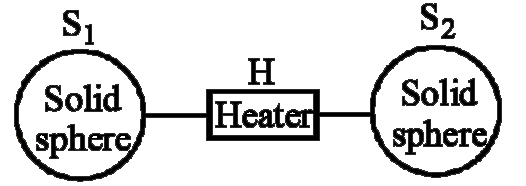A solid sphere S1 is connected to a charge reservoir through a heater H as shown in figure.

Flux through a closed spherical surface around S1 is given by ϕ=αt2 where α is a constant and t is time in seconds. If resistance of heater is R then select correct statements
(1) Power consumed by heater will be 4α2e20Rt2.
(2) Electric flux through a closed spherical surface around S2 will be –αt2.
(3) Rate of change of electric flux through a closed spherical surface around S2 will be –2αt
(4) All of the above are correct
1, 2 and 3 are correct
1 and 2 are correct
2 and 4 are correct
1 and 3 are correct
Step by step video & image solution for A solid sphere S_(1) is connected to a charge reservoir through a heater H as shown in figure. Flux through a closed spherical surface around S_(1) is given by phi = alpha t^(2) where alpha is a constant and t is time in seconds. If resistance of heater is R then select correct statements (1) Power consumed by heater will be 4alpha^(2)e_(0)^(2) Rt^(2). (2) Electric flux through a closed spherical surface around S_(2) will be – alpha t_(2). (3) Rate of change of electric flux through a closed spherical surface around S_(2) will be –2alpha t (4) All of the above are correct by Physics experts to help you in doubts & scoring excellent marks in Class 12 exams.
Updated on:21/07/2023Similar Questions
The magnetic flux through a loop is varying according to relation ϕ=6t2+7t+1 where ϕ is in milliweber and t is in second. What is the e.m.f. induced in the loop at t = 2 second ?
View SolutionA conducting sphere S1 intersects a closed surface S2 as shown in the figure.A positive charge q is placed at a point P .What is the value of electric flux through the surface S2 ? q P
View Solution
Knowledge Check
Time dependence of a physical quantity P is given by P=P0exp(−αt2), where α is a constant and t is time. The constant α is
AdimensionlessBhasdimensionsT−2Chas dimensions of P.DhasdimensionsT2Time dependence of a physical quantity P is given by P=P0exp(−αt2), where α is a constant and t is time. The constant α is
AdimensionlessBhas dimensions T−2Chas dimensions of P.Dhas dimensions T2The time dependence of a physical quantity P is given by P=P0 exp(−αt2), where α is a constant and t is time. The constant α
Ais dimensionlessBhas dimensions [T−2Chas dimensions of PDhas dimensions [T2]
The time dependence of a physical quantity P is given by P=P0e−αt2 , where α is a constant and t is time . Then constant α is//has
View SolutionThe time dependence of a physical quantity P is given by P=P0exp(−αt2), where α is a constant and t is time. The constant α
View SolutionA physical quantity Q is given by Q=Q0e−αt2 where t is the time and α is a constant. What is the dimensional formula for α?
View SolutionThe electric flux through a closed surface area S enclosing charge Q is ϕ If the surface area is doubled, then the flux is
View SolutionA rod of length l and cross-section area A has a variable thermal conductivity given by K = α T, where α is a positive constant and T is temperature in kelvin. Two ends of the rod are maintained at temperature T1 and T2 (T1>T2). Heat current flowing through the rod will be
View Solution